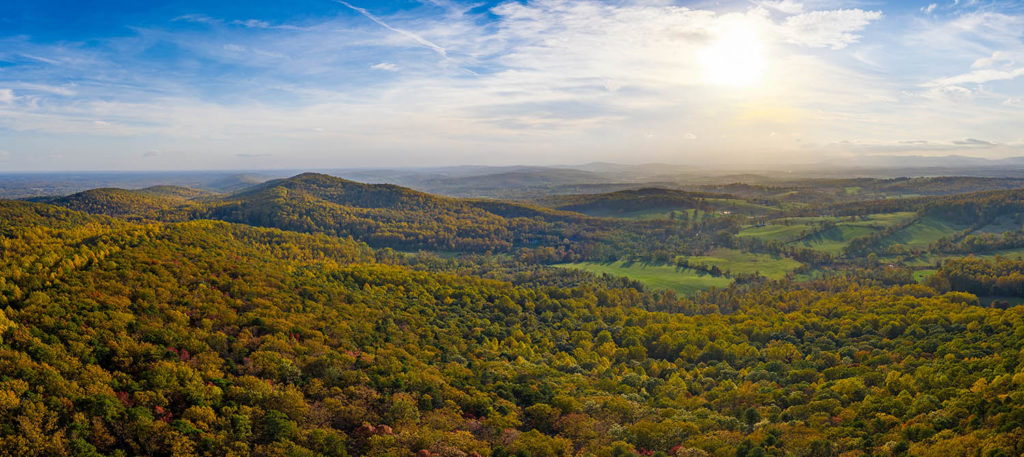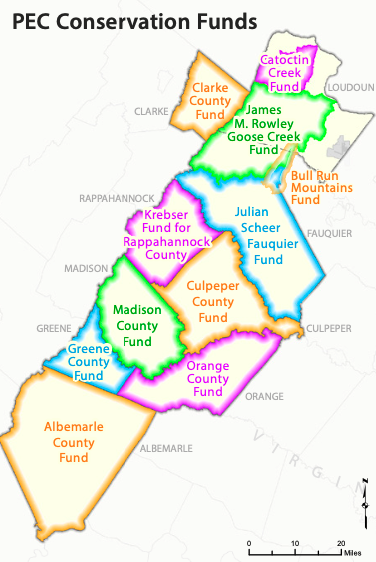
Stretching 15 miles from the village of Aldie in Loudoun County south to New Baltimore in Fauquier County, the Bull Run Mountains have stories to tell.
The mountain range is home to 10 unique plant, forest and woodland ecosystems supporting uncommon and threatened plant and animal species. Its hills were the scene of the Battle at Thoroughfare Gap during the Civil War. The rocky ridges and quartzite cliffs on its western side, along with the shadow of its eastern toe and its hollows, are said to have once guided slaves fleeing bondage via the Underground Railroad. Its mountainside is dotted with many historic ruins— cemeteries, house foundations, fence lines, and the Chapman-Beverly Mill built in 1742 among them—that dole out clues about the families and communities that once called these mountains home.
Now, PEC’s Bull Run Mountains Land Conservation Fund is helping the Virginia Outdoors Foundation conserve an historic property that’s an important part of the mountain’s story and the mountain itself. The 10-acre parcel in the Catlett’s Branch stream corridor is associated with the Robinson and Corum families, intertwined, prominent Bull Run Mountain families dating back at least 120 years, with branches of both enslaved and free.
The property adjoins land that is already protected as part of the Bull Run Mountains Natural Preserve Area—a designation bestowed upon 2,500 acres of this mountain range by the Commonwealth for its natural and historic resources. It still holds remnants of the original family homestead; stone walls, formerly cultivated fields, and a stone quarry are still perceptible. This property is special in and of itself, said VOF Deputy Director Leslie Grayson, but especially as a piece of a much bigger matrix of life in the mountains.
“If you go back to the 1800s and early 1900s, this area was not so wild, but was actually very peopled. There is a fascinating emerging history of free Black, post-Civil War Black, and poor White families eking a living out of the rocks and thin soils. It was a tough life of hand-sawn lumber, hand-quarried rock, no electricity, carrying water, hard work and hard living. Through VOF’s long-term cultural history project begun in earnest in 2019, we are trying to understand the stories of footprints and physical remnants of the people who lived here,” Grayson said.
“PEC’s Bull Run Mountain Conservation Fund is a donor-designated fund created in 1999 specifically to help conserve and protect Bull Run Mountain properties at risk for development. The fund kicked off a long partnership between PEC and VOF and has allowed us together to conserve 875 acres of land to help round out the natural preserve area,” said PEC Conservation Director Mike Kane. “We have always hoped this property would one day become part of the preserve.”
The property is heirs’ land—meaning it was passed down through generations without a will— and was nearly lost recently when a contract buyer approached one of its 19 co-owners about forcing a “partition sale” of the land. Heirs’ properties are particularly vulnerable to partition sales, because with many “co-owners” and no clear title, they offer none of the asset benefits but all of the financial liabilities typically associated with land ownership. As more heirs are born and others pass away, ownership becomes increasingly murky and far-removed, while escalating legal and financial burdens associated with it become unmanageable.
In 2020, VOF learned of the impending sale of this property and worked quickly to negotiate with the heirs and the buyer to acquire the property for incorporation into the Bull Run Mountain Natural Preserve Area. PEC’s Bull Run Mountain Land Conservation Fund is providing $25,000 of the $130,000 purchase price, which will relieve the heirs of outstanding tax liabilities, compensate the family and buyer for appraisal, survey work and other costs already incurred, and pay outstanding legal fees associated with the partition suit.
“At the end of the day, the hope of Virginia’s recently passed heirs’ property legislation is that the land stays in family hands, and that isn’t what happened here. But this acquisition is important because this property was being sold out of the family and would have eventually become yet another residential parcel. Now, it will be possible to preserve the family history along with the land itself,” Grayson said.
“VOF is working hard to piece together the story of the communities that historically called the preserve home. This property will be a critical addition to the preserve, not only protecting many wonderful natural resources, but also protecting an integral part of the mountain’s African American history,” she said.

This article was written by Cindy Sabato and appeared in The Piedmont Environmental Council’s spring 2021 member newsletter, The Piedmont View. If you’d like to become a PEC member or renew your membership, please visit pecva.org/join.
